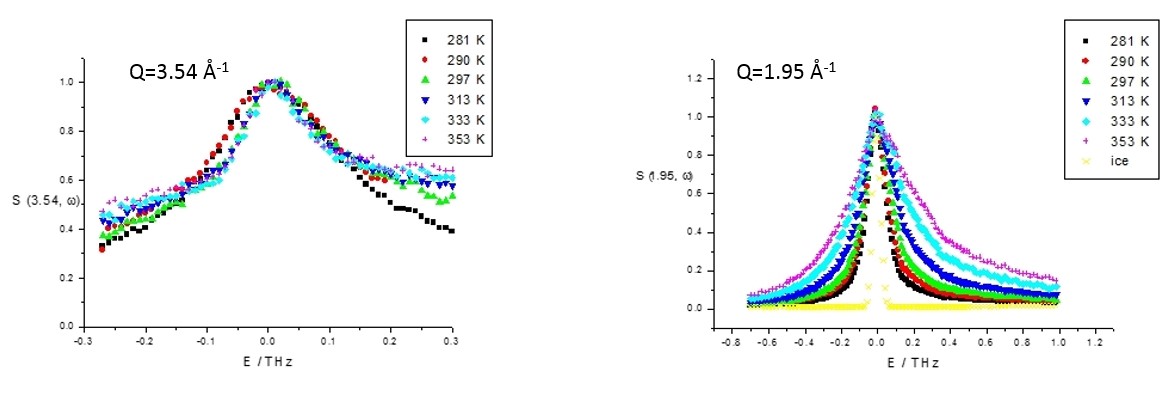- CEA
- CNRS |
- CEA Paris-Saclay |
- DRF Internet
- Iramis |
- LLB
- LLB intranet |
- VPN (Σigma - THOT - HORUS) |
- Webmail : Intra Extra
-
|

Laboratoire Léon Brillouin
UMR12 CEA-CNRS, Bât. 563 CEA Saclay
91191 Gif sur Yvette Cedex, France
+33-169085241 llb-sec@cea.fr
 The two dynamics of liquid water
The two dynamics of liquid water
Ice floating on water, flow of glaciers or insects walking on water surface are so common features that it is currently ignored that they are due to physical "anomalies". Indeed, paradoxically, the only natural liquid present on the Earth surface is not "normal" as compared to other less known liquids. It may look even more strange that the intermolecular potential at the origin of the complex behaviour of water remains partly unknown and that the best simulations of the molecular dynamics are based on "effective" potentials that replace the spherical molecule and the anisotropic potential by point charges and coulombic interactions.
The contributions of neutron scattering for tackling properties of water at the atomic scale have been very important. Because anomalies are enhanced at low temperature, measurements performed with supercooled water, down to -25 °C, are necessary despite technical difficulties. They can be achieved only through division of the necessary volume of samples into sets of tiny silica tubes in order to minimize effects of ice nucleation, although avoiding effects due to confinement.
Incoherent quasi-elastic neutron scattering is the best way to investigate individual motions of molecules due to the properties of hydrogen atoms but interpretation of data can be achieved similarly with different models, namely a separation into two components or through a distribution of relaxation times. Such experiments are naturally performed with H2O but measurements of the dynamics of D2O shed light on the nature of the motions because of the possible discrimination between dynamics of different partials of the pair correlation function.
 Indeed, selecting specific Q values, it is possible to maximise the contribution of one partial to the scattered intensity, thus to its dynamics. Concretely, at Q1=3.54 Å-1, almost all the scattered intensity of D2O is due to partial DD. Measuring the energy exchange at this Q value gives information about the dynamics of intermolecular hydrogen bonds. Conversely at Q2=1.95 Å-1 all the partials do contribute to the scattered intensity and the measured dynamics is that of the self-diffusion of the whole molecule. Despite the small magnitude of the measured intensity with D2O samples, this experiment, performed at LLB (Saclay), shows that molecular and hydrogen bond dynamics must be discriminated and that the temperature dependence of each of them is totally different (see attached figures). Measurements at Q2, where all partials contribute similarly, show the same anomalous temperature dependence as all transport properties of liquid water, strongly enhanced at low temperature. At the contrary, hydrogen bond dynamics, measured at Q1, depicts a classical Arrhenian temperature dependence [1]. Actually, given the small intensity of the scattering by D2O, the line width at Q1 appears like temperature independent but the experiment confirms previous analysis of data obtained with H2O, more precise but also more ambiguous because compatible with other interpretations. Such separation has been found in other neutron scattering experiments [2].
Indeed, selecting specific Q values, it is possible to maximise the contribution of one partial to the scattered intensity, thus to its dynamics. Concretely, at Q1=3.54 Å-1, almost all the scattered intensity of D2O is due to partial DD. Measuring the energy exchange at this Q value gives information about the dynamics of intermolecular hydrogen bonds. Conversely at Q2=1.95 Å-1 all the partials do contribute to the scattered intensity and the measured dynamics is that of the self-diffusion of the whole molecule. Despite the small magnitude of the measured intensity with D2O samples, this experiment, performed at LLB (Saclay), shows that molecular and hydrogen bond dynamics must be discriminated and that the temperature dependence of each of them is totally different (see attached figures). Measurements at Q2, where all partials contribute similarly, show the same anomalous temperature dependence as all transport properties of liquid water, strongly enhanced at low temperature. At the contrary, hydrogen bond dynamics, measured at Q1, depicts a classical Arrhenian temperature dependence [1]. Actually, given the small intensity of the scattering by D2O, the line width at Q1 appears like temperature independent but the experiment confirms previous analysis of data obtained with H2O, more precise but also more ambiguous because compatible with other interpretations. Such separation has been found in other neutron scattering experiments [2].
The apparent divergence of several properties of liquid water at the temperature of ice nucleation (around -40 °C) corresponds to the arrest of diffusion because of the large number of intermolecular bonds although the glass transition takes place only at much lower temperature (135 K) when the hydrogen bond dynamics is frozen [3].
[1] J. Teixeira, A. Luzar and S. Longeville, J. Phys.: Cond. Matter 18, S2353 (2006).
[2] J. Qvist, H. Schober and B. Halle, J. Chem. Phys. 134, 144508 (2011);
"Dielectric susceptibility of liquid water: microscopic insights from coherent and incoherent neutron scattering"
A. Arbe, P. Malo de Molina, F. Alvarez, B. Frick and J. Colmenero, Phys. Rev. Lett. 117, 185501 (2016).
[3] J. Teixeira, Mol. Phys. 110, 249 (2012).
